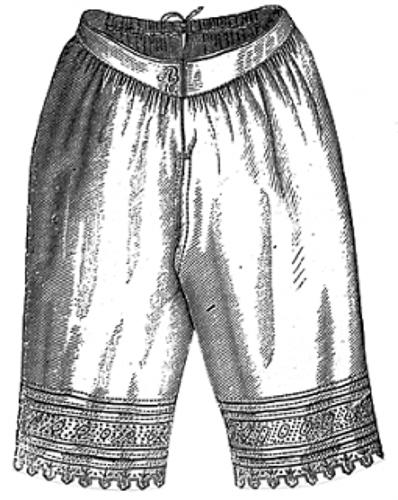Grandma Wore Bloomers
By Carroll Lisle

By the time I started remembering her, it was nearly 1940. Her cotton house dresses were neatly ironed, and her afternoon dresses were becoming. Ladies made a point of looking clean, curled, and alluring in their afternoon frock (even the word is hardly heard anymore!) when husbands returned from work.
Grandma had good posture. Her large figure was properly packaged, for Grandma wore a corset, a broad canvas-like bandeau of ties, straps, and hooks and eyes. She wore no brassiere, but instead, a soft camisole, the fabric varying with the season. The corset top rested on her upper rib cage. She’d pull and tug to fasten the hooks and eyes. Presumably, the crisscross tying in the back had been done to her measurement by the corset-maker. Occasionally she’d loosen some straps for relief after a big meal.
Dangling from the bottom of the corset were tabs to which her stockings could be attached. Over this corset she wore voluminous pink, silk underpants. Mostly, she wore elastic-banded underpants called bloomers after the longer variety from the Gay Nineties when women were them for bicycling. In summer, she chose step-ins with flared legs about the length of a mini-skirt.
Over this she wore a slip. Often this was of a luxurious fabric trimmed in lace. Straps were adjustable to alter the length, because, lace-trimmed or not, a slip should not show. 1
Her stockings were not nylon for that had not yet come into common use. They were silk, or they were lisle cotton. In either case the stockings were not transparent. Usually, she used garters, round rings or elastic, to hold them up. The stocking tops were rolled onto the garters.
At her age Grandma wore practical shoes. No longer was she wearing high heels. Hers were Cuban heels. Except for bedroom slippers, she did not wear flat shoes. To protect her shoes, she was not averse to wearing galoshes. These were ankle-high, black rubberized boots that went on over the shoes and either snapped or buckled to close. These overshoes were not very expensive, and that was a good thing because often the heel bottom wore out, and their effectiveness was lost.
Grandma wore a hat. Those the selected were not demure, but jaunty. Although most of hers were black, they were befeathered or befurred or bejeweled. She wore them with a flair. Her blue-white hair set them off. Her hats had wisps of veil, not full ones. In summer she did not wear a broad-brimmed straw hat. That simply wasn’t her style. It would have to be something rakish.
With the dying off of Grandma’s generation went corsets, galoshes, hats, gloves, and formality. Enter jeans and sweat shir,ts, tennis shoes, car coats, easy-care fabrics, and informality.
1 It’s raining; it’s snowing; your petticoat is showing!” was the schoolgirl chant.